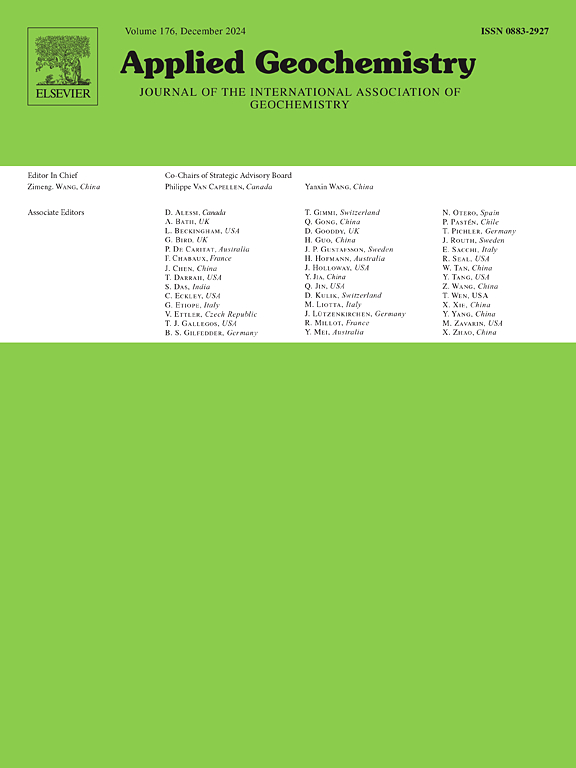Mechanisms controlling the release of inorganic contaminants, organic matter fractions, and ammonium from solid landfill waste: pH dependent leaching experiments and geochemical modelling
IF 3.4
3区 地球科学
Q1 GEOCHEMISTRY & GEOPHYSICS
引用次数: 0
Abstract
With the intention of making landfilling more sustainable, three full-scale projects have been set up to investigate the effects of leachate recirculation and aeration on the stabilization of contaminants. Prior to this (an)aerobic stabilization, solid waste was sampled from all three landfills to identify the mechanisms behind contaminant leaching and stabilization, as a reference point for evaluation of the treatment effects at a later stage of the project. Processes underlying the leaching of a wide range of inorganic contaminants were identified using a combined approach of pH dependent leaching experiments, organic matter fractionation, and geochemical modelling. We additionally focused on organic matter, being an important surface controlling the leaching of inorganic elements, and ammonium, for which compliance with intended environmental limit values for sustainable landfill management is challenging for many landfills. Three types of pH dependent leaching behaviour could be identified for the investigated elements: non-reactive behaviour, anionic behaviour, and cationic behaviour. Reactive elements, including ammonium, showed maximum dissolved concentrations around the upper and lower ends of the pH range, while leaching of non-reactive elements was pH-independent. Organic matter became increasingly soluble with increasing pH, while its relative composition became increasingly enriched in fractions reactive for metal binding, most notably humic acid, only for the most organic landfill. The organic signature of the waste samples, together with their varying organic matter content, resulted in distinct differences in leaching behaviour between landfills. These differences result from the seemingly strong influence of organic matter on the pH at which minimum solubility of elements occurs, being lower for elements with higher organic matter binding affinity, an effect being more pronounced for more organic-rich samples. The model, based on independently determined generic sorption parameters, provided adequate descriptions of most elements, yet arsenic and ammonium were poorly described due to mechanisms not captured by the model while chromium was inadequately described due to limitations of the current binding parameters. As the three landfills have been shown to differ strongly with respect to waste properties (e.g. organic versus. inorganic) an important outcome of this study is that landfill-specific combinations of proposed treatment strategies (aeration, leachate recirculation) are necessary to reduce the leaching of specific contaminant groups to below limit values and are anticipated to be most effective for less mature landfills characterized by a lower ratio of solid to dissolved OM.
控制无机污染物释放的机制,有机物质组分,和固体垃圾填埋场的铵:pH依赖浸出实验和地球化学模型
为了使堆填区更具可持续性,我们已展开三个全面的项目,研究渗滤液循环和曝气对稳定污染物的影响。在进行有氧稳定之前,从所有三个垃圾填埋场取样固体废物,以确定污染物浸出和稳定背后的机制,作为项目后期处理效果评估的参考点。利用pH依赖性浸出实验、有机物分选和地球化学模型的组合方法,确定了广泛的无机污染物浸出的过程。我们还关注有机物质,作为控制无机元素和铵浸出的重要表面,对于许多垃圾填埋场来说,要符合可持续垃圾填埋场管理的预期环境限值是一项挑战。对于所研究的元素,可以确定三种类型的pH依赖性浸出行为:非反应性行为,阴离子行为和阳离子行为。包括铵在内的活性元素在pH范围的上端和下端表现出最大溶解浓度,而非活性元素的浸出与pH无关。随着pH值的增加,有机质的可溶性越来越强,而其相对组成在金属结合活性组分中越来越丰富,最明显的是腐植酸,仅在最有机的垃圾填埋场中。废物样品的有机特征,以及它们不同的有机质含量,导致了不同填埋场的浸出行为的明显差异。这些差异是由于有机物对pH值的强烈影响造成的,在pH值下元素的溶解度最低,对于有机物结合亲和力较高的元素,溶解度较低,对于富含有机物的样品,这种影响更为明显。该模型基于独立确定的一般吸附参数,提供了对大多数元素的充分描述,但由于模型未捕获的机制,砷和铵的描述很差,而铬由于当前结合参数的限制而描述不充分。由于三种垃圾填埋场已被证明在废物特性方面存在很大差异(例如,有机与无机)。本研究的一个重要结果是,所提出的处理策略(曝气、渗滤液再循环)的特定垃圾填埋场组合是必要的,可以将特定污染物组的浸出降低到限值以下,并且预计对以固体与溶解OM的比例较低为特征的不太成熟的垃圾填埋场最有效。
本文章由计算机程序翻译,如有差异,请以英文原文为准。
求助全文
约1分钟内获得全文
求助全文
来源期刊

Applied Geochemistry
地学-地球化学与地球物理
CiteScore
6.10
自引率
8.80%
发文量
272
审稿时长
65 days
期刊介绍:
Applied Geochemistry is an international journal devoted to publication of original research papers, rapid research communications and selected review papers in geochemistry and urban geochemistry which have some practical application to an aspect of human endeavour, such as the preservation of the environment, health, waste disposal and the search for resources. Papers on applications of inorganic, organic and isotope geochemistry and geochemical processes are therefore welcome provided they meet the main criterion. Spatial and temporal monitoring case studies are only of interest to our international readership if they present new ideas of broad application.
Topics covered include: (1) Environmental geochemistry (including natural and anthropogenic aspects, and protection and remediation strategies); (2) Hydrogeochemistry (surface and groundwater); (3) Medical (urban) geochemistry; (4) The search for energy resources (in particular unconventional oil and gas or emerging metal resources); (5) Energy exploitation (in particular geothermal energy and CCS); (6) Upgrading of energy and mineral resources where there is a direct geochemical application; and (7) Waste disposal, including nuclear waste disposal.
 求助内容:
求助内容: 应助结果提醒方式:
应助结果提醒方式:


